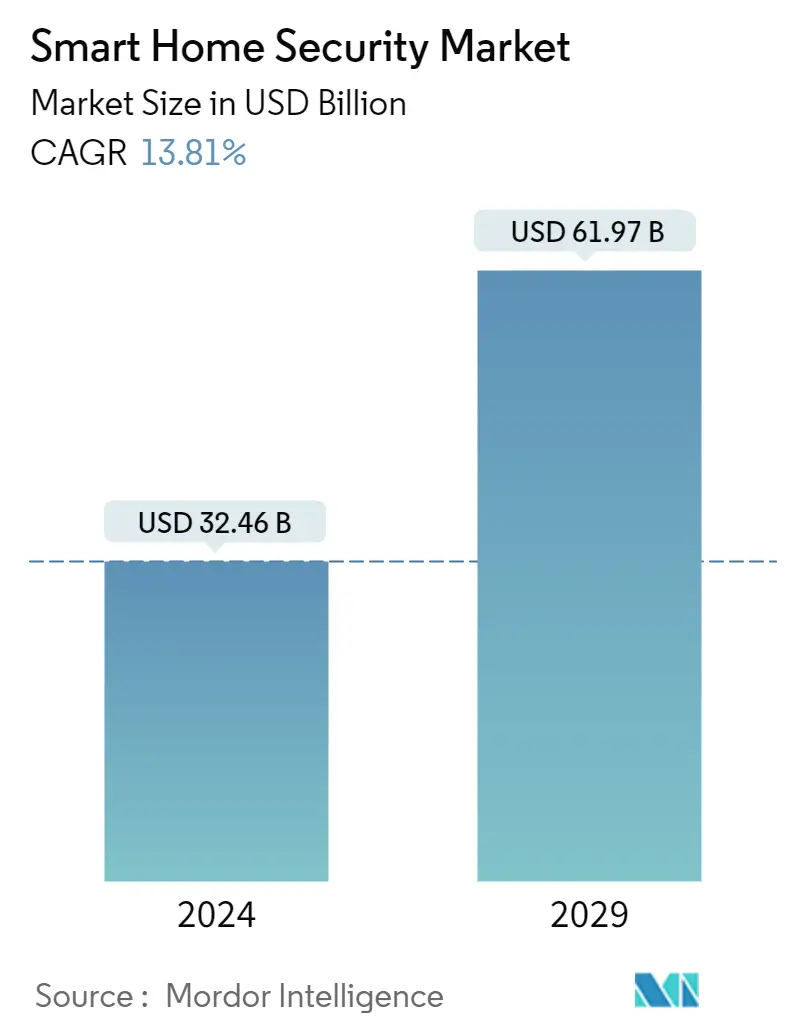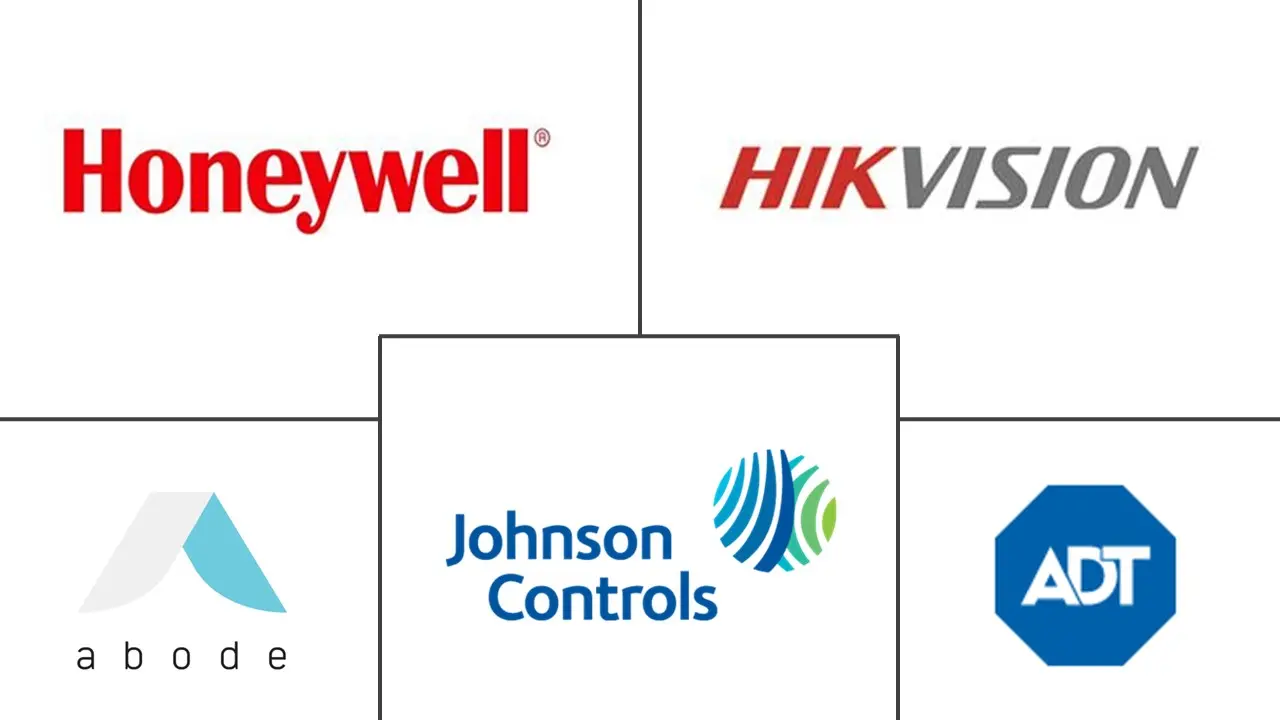Market Size of Smart Home Security Industry

| Study Period | 2019 - 2029 |
| Market Size (2024) | USD 32.46 Billion |
| Market Size (2029) | USD 61.97 Billion |
| CAGR (2024 - 2029) | 13.81 % |
| Fastest Growing Market | Asia-Pacific |
| Largest Market | North America |
Major Players
*Disclaimer: Major Players sorted in no particular order |
Smart Home Security Market Analysis
The Smart Home Security Market size is estimated at USD 32.46 billion in 2024, and is expected to reach USD 61.97 billion by 2029, growing at a CAGR of 13.81% during the forecast period (2024-2029).
The rising number of internet users, rapidly growing adoption of smartphones and smart gadgets, and the increasing concern about remote house monitoring are the key factors driving the growth of smart home security market. Furthermore, rising crime rates around the world are fueling industry growth.
- The introduction of IoT and favorable policies created a solid basis for the smart home security market. By 2025, the GSMA predicts that China will likely account for around 4.1 billion IoT connections or about one-third of all IoT connections worldwide. In addition, programs like the Made in China 2025 strategy, the National New-type Urbanization Plan, and the Smart Cities Projects are anticipated to drive the growth of China's smart home security market. Most companies and vendors in China compete to stay dominant in the market as the overall demand for the installation of AI-powered security cameras in homes is growing massively, offering homeowners greater security features, such as timely intruder alarms or notifications when their loved ones arrive home.
- According to Bunning's study, a prominent home improvement retailer and outdoor living products in Australia and New Zealand, smart home technology is growing in Australia, with around 49% of the population now having some form of this technology. The company's study also uncovered that 1 in 2 Australians use their smart home technology daily, with general security (61%) and protection against intruders (44%) the most significant drivers for uptake. Security camera systems are the biggest mover in the space, with Bunning's study predicting that most Australians would install some security device in their home in the next five years. However, with the numerous benefits of smart home security products, they could leave homeowners more vulnerable to digital threats, and these devices are potential points of entry for cybercriminals who wish to access personal data. These concerns are challenging the market growth.
- Moreover, Google Assistants and Amazon Alexa are compatible with home security systems. Thermostats, smart locks, cameras, doorbells, wall-mounted touchscreen displays, smartphone apps, Google Assistants, and Alexa are all integrated into home security systems, in addition to others. The connectivity between these devices allows for constant home security. Including additional features such as carbon monoxide (CO) listeners, flood and freezing alarms, and other recent technologically enhanced security systems expands the potential for new markets for smart home security systems. Furthermore, Z-Wave-compatible smart home alarm systems use Wi-Fi-enabled cameras to monitor homes using sound detection and panoramic videos.
- The Covid-19 pandemic significantly negatively affected the expansion of the worldwide home security systems industry. Due to production hiccups and temporary transportation system shutdowns, global sales declined precipitously during that period. The supply chain interruption in China caused a sharp fall in demand for home security systems, severely impacting key markets worldwide. Some reasons affecting demand in China include the drop in new development projects and the closure of production plants. However, as the market recovers in 2021, the US and China are expected to re-emerge as major countries in the home security systems market.
Smart Home Security Industry Segmentation
Smart home security employs IoT-enabled gadgets to enable customers to monitor and manage their home's security, including door access and surveillance. Smart home security uses an assortment of IoT-enabled technologies to enable consumers to monitor and manage the security of their houses remotely.
The smart home security market is segmented by component (hardware, software, services), device type (smart alarms, smart locks, smart sensors and detectors, smart camera and monitoring systems), communication module (professionally monitored, self-monitored), and geography (North America, Europe, Asia Pacific, Latin America, Middle East and Africa). The market sizes and forecasts are provided in terms of value (USD) for all the above segments.
| By Component | |
| Hardware | |
| Software | |
| Services |
| By Device Type | |
| Smart Alarms | |
| Smart Locks | |
| Smart Sensors and Detectors | |
| Smart Camera and Monitoring System | |
| Other Device Types |
| By Communication Module | |
| Professional Monitored | |
| Self Monitored |
| By Geography | |||||||
| |||||||
| |||||||
| |||||||
| |||||||
|
Smart Home Security Market Size Summary
The smart home security market is experiencing significant growth, driven by the increasing number of internet users, the rapid adoption of smartphones and smart gadgets, and heightened concerns about remote house monitoring. The market is further bolstered by the rising crime rates globally, which have intensified the demand for advanced security solutions. The integration of IoT technologies and supportive policies have established a robust foundation for the market's expansion. In regions like China, strategic initiatives such as the Made in China 2025 strategy and Smart Cities Projects are expected to propel market growth, with companies competing to dominate the market by offering AI-powered security features. Similarly, in Australia, a substantial portion of the population is embracing smart home technology, with security cameras leading the charge in adoption. However, the proliferation of these devices also raises concerns about potential digital vulnerabilities, posing challenges to market growth.
The market landscape is characterized by a high degree of fragmentation, with major players like ADT Inc., Honeywell International Inc., and Johnson Controls International PLC leading the charge. The United States stands out as a prominent market in North America, driven by the growing adoption of smart home technology and the perceived security benefits. Strategic partnerships and innovations are key drivers of the industry, with companies like Volt and ADT Inc. enhancing their offerings through collaborations and new product launches. The market is also witnessing a trend towards DIY smart home security systems, although professional installation services remain strong, particularly in response to the needs of remote workers. Despite the challenges posed by the COVID-19 pandemic, the market is on a recovery path, with countries like the US and China expected to re-emerge as key players in the global smart home security market.
Smart Home Security Market Size - Table of Contents
-
1. MARKET INSIGHTS
-
1.1 Market Overview
-
1.2 Industry Attractiveness - Porter's Five Forces Analysis
-
1.2.1 Bargaining Power of Suppliers
-
1.2.2 Bargaining Power of Buyers
-
1.2.3 Threat of New Entrants
-
1.2.4 Threat of Substitutes
-
1.2.5 Intensity of Competitive Rivalry
-
-
1.3 Industry Value Chain Analysis
-
1.4 Assessment of Impact of COVID-19 on the Market
-
-
2. MARKET SEGMENTATION
-
2.1 By Component
-
2.1.1 Hardware
-
2.1.2 Software
-
2.1.3 Services
-
-
2.2 By Device Type
-
2.2.1 Smart Alarms
-
2.2.2 Smart Locks
-
2.2.3 Smart Sensors and Detectors
-
2.2.4 Smart Camera and Monitoring System
-
2.2.5 Other Device Types
-
-
2.3 By Communication Module
-
2.3.1 Professional Monitored
-
2.3.2 Self Monitored
-
-
2.4 By Geography
-
2.4.1 North America
-
2.4.1.1 United States
-
2.4.1.2 Canada
-
-
2.4.2 Europe
-
2.4.2.1 Germany
-
2.4.2.2 United Kingdom
-
2.4.2.3 Norway
-
2.4.2.4 Denmark
-
2.4.2.5 Rest of Europe
-
-
2.4.3 Asia-Pacific
-
2.4.3.1 China
-
2.4.3.2 Japan
-
2.4.3.3 South Korea
-
2.4.3.4 Rest of Asia-Pacific
-
-
2.4.4 Latin America
-
2.4.4.1 Mexico
-
2.4.4.2 Brazil
-
2.4.4.3 Rest of Latin America
-
-
2.4.5 Middle East and Africa
-
2.4.5.1 United Arab Emirates
-
2.4.5.2 Saudi Arabia
-
2.4.5.3 South Africa
-
2.4.5.4 Rest of Middle East and Africa
-
-
-
Smart Home Security Market Size FAQs
How big is the Smart Home Security Market?
The Smart Home Security Market size is expected to reach USD 32.46 billion in 2024 and grow at a CAGR of 13.81% to reach USD 61.97 billion by 2029.
What is the current Smart Home Security Market size?
In 2024, the Smart Home Security Market size is expected to reach USD 32.46 billion.

